Malcolm R. Campbell's Blog, page 40
December 14, 2022
Typical e-mail exchange with a shipper
This is the season when UPS, FedEx, and USPS litter the front porch with packages and my e-mail inbox with notes that say “your shipment has arrived.” But sometimes the shipper is wrong and there’s no package there:
 SHIPPER: (Not FedEx) Your package from WALMART arrived today.
SHIPPER: (Not FedEx) Your package from WALMART arrived today.
ME: No it didn’t.
SHIPPER: Really? Did you check the outhouse?
ME: We don’t have an outhouse.
SHIPPER: Where do you do your business?
ME: The bathroom.
SHIPPER: Wow, we didn’t figure a redneck county like yours had indoor plumbing.,
ME: So where’s my package?
SHIPPER: Frankly, we rather hoped you’d forgotten about it by now. We think varmints ran off with it.
ME: Varmints?
SHIPPER: Yes, lions, tigers, and bears, oh my.
ME: I live in Georgia, not the jungle.
SHIPPER: So that “Georgia of the Jungle” song isn’t about you?
ME: Nope.
SHIPPER: Well, bugger.
Malcolm
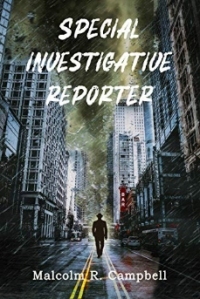 Malcolm R. Campbell sometimes put his satire in a novel.
Malcolm R. Campbell sometimes put his satire in a novel.
December 12, 2022
One with the Universe
While writing yesterday’s post about the I Ching, I thought of that long-ago phrase that was once very popular: “One with the Universe.” Unfortunately, “everyone” used that phase so extensively that it became trite and that didn’t matter because most people weren’t really applying it, they were just saying it.
Those of us who have studied Huna (Hawai’ian mysticism) see no difference between the universe and the Creator. Some Huna scholars put it this way: “There is nothing that’s not God.”
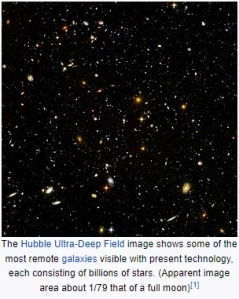 Whether you see all that is as a Huna mystic or as a member of a group with another approach to the “Cosmic,” it seems clear that if we are all doing our best to synchronize our lives with the universe–perhaps via the I Ching–we would not have the spectre of climate change hanging over our heads like the sword of Damocles.
Whether you see all that is as a Huna mystic or as a member of a group with another approach to the “Cosmic,” it seems clear that if we are all doing our best to synchronize our lives with the universe–perhaps via the I Ching–we would not have the spectre of climate change hanging over our heads like the sword of Damocles.
It’s a shame we have left the world in an apparently perilous condition for our children and our children’s children. This reminds me of those novels where a once proud family falls into ruin because the older generation didn’t manage the estate properly. We are not managing the World’s resources properly, evidence enough in my view that most of us are not one with the universe.
If you look up “one with the universe” in Google, for example, you’ll find multiple commentaries on how to synchronize your life, thinking, and work with the universe. The best of these tend to say that doing so will make a difference in ourselves and then in the state of the World. It’s easy to get discouraged and think, “okay, I’m doing my bit, but what difference can it possibly make?” the answer is always “More than you know.” When you think of the “six degrees of separation” concept, then it becomes clear that we aren’t all that far apart when we decide to act or change the way we think.
Many of us are fed up trying to get the “powers that be” to do something realistic about climate change. Not that we should stop trying. But we can increase the odds of success by synchronizing ourselves with the universe. Doing so is more powerful than all the letters we can write to government agencies.
December 11, 2022
Aligning oneself with change with the ‘I Ching’
 I no longer remember what led me to the Book of Changes known as the I Ching. Most likely it was something Carl Jung wrote. He was a friend of sinologist Richard Wilhelm (1873-1930) who brought to the western mind the first translation of the I Ching, a work that so impressed Jung that he wrote a forward to it. I believe it was first translated into English in 1951 and, of all the translations, some say it is still the best.
I no longer remember what led me to the Book of Changes known as the I Ching. Most likely it was something Carl Jung wrote. He was a friend of sinologist Richard Wilhelm (1873-1930) who brought to the western mind the first translation of the I Ching, a work that so impressed Jung that he wrote a forward to it. I believe it was first translated into English in 1951 and, of all the translations, some say it is still the best.
According to Princeton University Press, “The I Ching, or Book of Changes, a common source for both Confucianist and Taoist philosophy, is one of the first efforts of the human mind to place itself within the universe. It has exerted a living influence in China for 3,000 years, and interest in it has been rapidly spreading in the West.”
The universe, we suspect, is always in a state of flux, sometimes favoring things we may consider doing and sometimes not. The I Ching when used as an oracle shows us whether or not conditions are right for our plans just as a weather report tells us whether today is a good day to put out to sea. Most sailors wouldn’t begin a sea voyage in a hurricane. Likewise, when considering conditions with the I Ching, those with a Taoist perspective wouldn’t begin a project on a day when doing so goes against the universal flow.
In his foreword to the Wilhem edition, Jung said, “For more than thirty years I have interested myself in this oracle technique, or method of exploring the unconscious, for it has seemed to me of uncommon significance. I was already fairly familiar with the I Ching when I first met Wilhelm in the early nineteen twenties; he confirmed for me then what I already knew, and taught me many things more.”
As an oracle, used for divination or for meditation, The I Ching is–so to speak–like a wise and all-knowing companion on one’s life’s journey. I probably started using the I Ching in high school and, basically, found that when I used it often, life just seemed to go more smoothly. I still have my original copy, though I’ve supplemented it with Rudolph Ritsema and Stephen Karcher’s I Ching: The Classic Chinese Oracle of Change [The First Complete Translation with Concordance].
The publisher’s description said, “We need the book when we stand at a crossroad of the soul.” I agree. The book’s answers to a flippant question are often like getting one’s hands slapped So, don’t ask it where you left your car keys or if you’re going to “get lucky” on your date tonight.

In this 1995 edition, the authors write, “The I Ching is a diviner’s manual or active sourcebook for what C. G. Jung called the archetypal forces. It organizes the play of these forces into images so that an individual reading becomes possible. . . These forces represent the flow of life and the experience of its meaning, its way or tao.”
Consistent use of the I Ching slowly changes an individual view of and approach to life. This benefit cannot be overstated.
I believe that most of our problems come from the arrogance of living outside the universe, a belief the I Ching would caution the seeker against.
–Malcolm
December 5, 2022
‘The Blue Angel’ with Marlene Dietrich and Emil Jannings
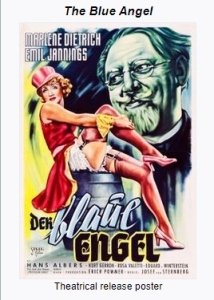 “The Blue Angel” directed by Josef von Sternberg was released in 1930 and, as Wikipedia describes it, ” presents the tragic transformation of a respectable professor to a cabaret clown and his descent into madness.” It’s often called a comedy-drama, but that seems based on short moments of humor in a film that shows how easy it is for a man to walk into a cabaret for innocent reasons and end up being corrupted by the predators there. Two versions of the film were made, one in German with English subtitles and one in English. The English version is an inferior production in part because speaking in fractured English completely destroys the atmosphere of the film.
“The Blue Angel” directed by Josef von Sternberg was released in 1930 and, as Wikipedia describes it, ” presents the tragic transformation of a respectable professor to a cabaret clown and his descent into madness.” It’s often called a comedy-drama, but that seems based on short moments of humor in a film that shows how easy it is for a man to walk into a cabaret for innocent reasons and end up being corrupted by the predators there. Two versions of the film were made, one in German with English subtitles and one in English. The English version is an inferior production in part because speaking in fractured English completely destroys the atmosphere of the film.
I probably shouldn’t have told my daughter during our Thanksgiving visit that “The Blue Angel” is one of my favorite films. We had been talking about my love of noir films and movies with nasty characters like “The Little Foxes.” She hadn’t seen most of those I mentioned so I told her if she wants to see rock-bottom depravity (and, I mean, who doesn’t?) she should check out Marlene Dietrich’s and Emil Jannings’ performances in this film. As a writer, I often consider the workings of the dark side and how easy it is to become enamored of it until it kills you.
Of the film, the late Roger Ebert wrote, “‘The Blue Angel’ looks and feels more like a silent film, with its broad performances that underline emotions. Von Sternberg, who was raised in Europe and America and began his career in Hollywood, was much influenced by German expressionism, as we see in early street scenes where the buildings tilt toward each other at crazy angles reminiscent of ‘The Cabinet of Dr. Caligari.’ He was a bold visual artist who liked shots where the actors shared space with foreground props and dramatic shadows, and he makes the dressing room beneath the stage of the Blue Angel nightclub into a haunting psychic dungeon.”
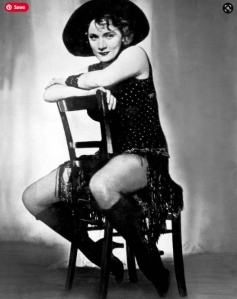 Lola Lola
Lola Lola
While he went on to make additional films with Dietrich, I see this as their best collaboration in part because of those “broad Performances” that Ebert mentions, That sweet song “Falling in Love Again (Can’t Help It)” is a haunting and chilling refrain behind the characters, especially Dietrich, a complex individual who brought those complexities to her work. She worked with von Sternberg in “Morocco,” “Dishonored,” “Shanghai Express,” “Blonde Venus,” “The Scarlet Empress,” and “The Devil Is a Woman” among other films.
Thomas Caldwell writes that “The vampish woman (Lola Lola) is a force of powerful sexuality, which is aligned with the deadly forces of nature (her animal print costumes and the exoticness of The Blue Angel club) and otherness. Professor Immanuel Rath is the lonely and sympathetic male aligned with civilisation (he is a respected teacher) who falls prey to her untamed femininity. Although by today’s standards the symbolism is inappropriate, the scene where Rath wakes up with a black doll represents the dark and mysterious foreignness of Lola Lola that is alluring yet ultimately dangerous and unattainable. Dietrich’s portrayal of Lola Lola would be extremely influential in the creation of the femme fatale personae that dominated the Hollywood film noir cycle of films.”
The professor cannot help himself. That’s the message I see here as well as the danger of “everyday people” walking into a cabaret or bar where the rules are different and without mercy.
–Malcolm
 Malcolm R. Campbell is the author of “Special Investigative reporter,” a novel about a jaded reporter who sees the dark side in the news of the day,
Malcolm R. Campbell is the author of “Special Investigative reporter,” a novel about a jaded reporter who sees the dark side in the news of the day,
December 4, 2022
Rumours About Christmas
Got a tip from a reasonably informed source: “The Christmas people are at it again.”
 Even though it was March, I drove downtown in my 1950 A4 Checker (for you young people, that’s a car, not an Internet fact checker) in a cold wind that raged drunkenly beneath black clouds that looked like they’d been painted onto a frightening sky by Salvador Dalí during one of his less-lucid moments.
Even though it was March, I drove downtown in my 1950 A4 Checker (for you young people, that’s a car, not an Internet fact checker) in a cold wind that raged drunkenly beneath black clouds that looked like they’d been painted onto a frightening sky by Salvador Dalí during one of his less-lucid moments.
Arrived at the Max Value Department Store at high noon, heard a clock ticking, saw a used-up department store Santa singing “Do not forsake me oh my darling.” He waived as though we were the same kind of people even though we aren’t.
There was a line of Christman trees with bright burning candles in the store window (actually behind the window) hovering over a pile of brown pine needles, crumpled tinsel, last year’s gifts, and last year’s dreams.
I waited until September and drove downtown again, saw that Max Value had burnt to the ground, demonstrating the danger of placing candles on Christmas trees. Nearby stores that hadn’t burnt down yet due to the vicissitudes of mob looting that is no longer a crime in most cities, already had factory-fresh trees and garlands, ribbons and bows, stacks of toys I’d never heard of, and signs that proclaimed, “To Hell With Hallowe’en and Thanksgiving, we’re merrily geared up for Christmas.”
I felt lower than Jimmy Hoffa at the bottom of the river with concrete shoes.
Skipping Hallowe’en was fine with me because I think the holiday is meant for dead people. But Thanksgiving. Ignoring that day is a crime in enlighted cities that feature skies painted by Thomas Kinkade. My town was still stuck with Dalí skies, Piccasso streets, and Picasso people that had eyes in all the wrong places. It was obvious to me why nobody cared about Hallowe’en or Thanksgiving: the world was filled with people who can’t see straight or who are blind or who escaped from an asylum.
I walked up to a store manager and said, “It’s not even Black Friday yet.” He laughed like that evil doll in a movie I wish I’d never seen and said “Corporate Calls the shots. Next year, we’re putting up our Christmas displays during the dog days of August.” “I assume there’s a discount for the fleas,” I said. “Hardly. Folks give them to their cat-loving friends as gag gifts.”
I left before I got angry enough to kill him.
The clean-cut Santa standing outside the main door was so fat, I decided he was already eating turkey. When I got home, I heated up a roast turkey TV dinner, thankful that everyone who knows me won’t accept any cards or gifts from me because “I’m out of touch” and proud of it.
Jock Stewart
December 3, 2022
Marietta House Museum, Glendale, MD
“Marietta is a historic house and former tobacco plantation located in Glenn Dale, Prince George’s County, Maryland. On the National Register of Historic Places and the National Underground Railroad Network to Freedom, Marietta House Museum includes a federal era house, a cemetery, the original root cellar, and harness room, as well as Judge Gabriel Duvall’s original law office building. The historic site sits on 25 acres of Marietta’s original 690 acres. Today, visitors can walk the grounds and tour the plantation buildings and sites where free and enslaved people lived and labored.” – Wikipedia
 While visiting my daughter’s family in Maryland for Thanksgiving, we all took a guided tour of Marietta House and learned more about slavery in Maryland. My daughter’s husband stayed home working on the Thanksgiving dinner. It was fabulous.
While visiting my daughter’s family in Maryland for Thanksgiving, we all took a guided tour of Marietta House and learned more about slavery in Maryland. My daughter’s husband stayed home working on the Thanksgiving dinner. It was fabulous.
According to the website, “Marietta was built for Gabriel Duvall, one of Prince George’s County’s most outstanding citizens. Born in 1752, Duvall pursued a career of public service which lasted for more than 60 years. After serving in several positions during the Revolutionary War, he served in the Maryland House of Delegates, the United States Congress, the Maryland Supreme Court, and as Comptroller of the Treasury under Thomas Jefferson. Soon after 1812, when he was appointed by President James Madison to the U.S. Supreme Court, Duvall began the construction of Marietta. Over the next 20 years, he developed the 325-acre plantation and constructed a substantial rear wing for added living space. He served on the Supreme Court until 1835; in January of that year, he retired to spend the rest of his life at Marietta, where he died in 1844. Marietta remained the residence of his heirs until 1902.”
My granddaughters have visited a lot of museums and other sites, so they’re used to tours, displays of historic furnishings, and signage that describes the exhibits and the importance of the place. I do believe they liked the Christmas tree, toys, and cards that showed a very different era than they are familiar with. I’m less sure they were enthusiastic about the simulated food displays on the table in the kitchen. As for the irons lined up on the hearth–well, I wonder if they had a clue what those things would be used for what with today’s no-iron clothes.
If you like history, you might put this destination on your list of places to see if you live in or travel to Maryland.
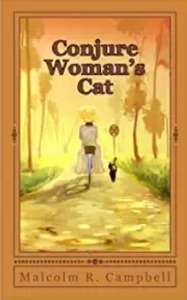 Malcolm R. Campbell is the author of “Conjure Woman’s Cat.”
Malcolm R. Campbell is the author of “Conjure Woman’s Cat.”
December 2, 2022
‘Fruits of Eden’ by Patricia Damery
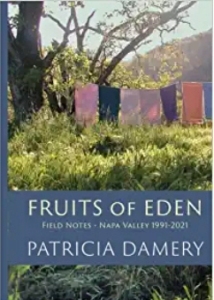 I have mourned the overdevelopment in California (the state where I was born) and the overdevelopment in Florida (the state where I grew up). In both cases, environmentally diverse and beautiful states have been ruined and badly compromised for the sake of tourism and development that left no stone unturned in raping the best areas first. The late Atlanta historian, Franklin Garrett, called this approach to land use within a city “municipal vandalism.” Insofar as California and Florida are concerned, I call it near-criminal destruction of the land. Years ago, a minister said the real Garden of Eden was in west Florida. If that had proven true, it would have been paved over by now.
I have mourned the overdevelopment in California (the state where I was born) and the overdevelopment in Florida (the state where I grew up). In both cases, environmentally diverse and beautiful states have been ruined and badly compromised for the sake of tourism and development that left no stone unturned in raping the best areas first. The late Atlanta historian, Franklin Garrett, called this approach to land use within a city “municipal vandalism.” Insofar as California and Florida are concerned, I call it near-criminal destruction of the land. Years ago, a minister said the real Garden of Eden was in west Florida. If that had proven true, it would have been paved over by now.
So I warn you, I supported this book before I even saw it.
I must also confess that I have known Patricia Damery online for years and enthusiastically reviewed her earlier books. This book comes from the front lines of climate change and bad land-use practices. So, I can’t help but show it to you in spite of my prospective biases. By the way, you can see an interview with Pat here. The book comes in two editions, one with the interior photographs in color, and the other in black and white.
From the Publisher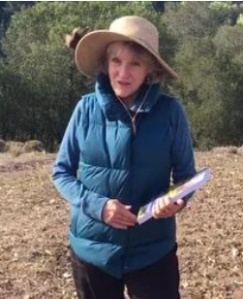 Damery – Napa Valley Register Photo
Damery – Napa Valley Register Photo
In Fruits of Eden, author Patricia Damery takes readers on a thirty-year journey, vividly recounting her citizen activism to protect the world-famous Napa Valley from the ravages of over-development, water plundering, government failures, greed, and damaging tourism.
Damery’s articulate and Illustrative voice is a powerful call that interweaves the story of her ranch with her history, reflections, marriage, and her husband’s onset of dementia. His Alzheimer’s began at the same time as pressure on the ranch’s sustainability became acute. Conversely, there is also great hope. The author’s relationships with colleagues in action for the valley, her children, her grandchildren and friends all share a deep love for this extraordinary place on the planet.
Over the decades Damery and her husband, Donald Harms, developed a way of life that respected the natural ecology of their land in the Napa Valley. They applied organic and biodynamic methods, left large parts in their natural state, and had a herd of goats that lived next to Patricia’s writing studio. Then climate change coupled with egregious overdevelopment overcame them, threatening to destroy their way of life. Destruction of native oaks caused erosion and groundwater depletion, insecticide use disrupted the balance of animal life, including beneficial insects, population density and tourism
–
I visited Napa Valley multiple times before the nefarious amongst us began turning it into hell. I don’t want to go back there again any more than I want to see again what the fools who created Daytona Beach have done to the once-precious land along the Atlantic coast. But with the help of books like Fruits of Eden and their from-the-trenches authors, maybe we can save some of the endangered Edens that remain.
November 30, 2022
Thanksgiving is a time for visiting family in Maryland
 We enjoy visiting my daughter and her family in Maryland at Thanksgiving even if arthritis in my ankles has gotten to the point where I have to use a wheelchair to get through Reagan airport in Washington. We rent a car there and drive to Rockville, MD for a great time.
We enjoy visiting my daughter and her family in Maryland at Thanksgiving even if arthritis in my ankles has gotten to the point where I have to use a wheelchair to get through Reagan airport in Washington. We rent a car there and drive to Rockville, MD for a great time.
My daughter Johanna is a planner. That means there’s plenty to do and see in addition to my granddaughters, Freya and Beatrice.
We enjoyed seeing the winter lights at nearby Gaithersburg and a production at the great old Weinberg theater in Frederick. The theater’s been around since 1926 and has, I think, the oldest theater organ in the country that’s still in its original location. I’d like to hear that old Wurlitzer sometime.
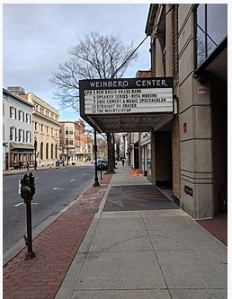 Johanna’s husband Kevin could give Chef Ramsay a run for this money. This means a wonderful Thanksgiving dinner.
Johanna’s husband Kevin could give Chef Ramsay a run for this money. This means a wonderful Thanksgiving dinner.
The trip home was another matter. The storm system that has brought tornados to the southeast brought us a bumpy flight into Chattanooga and one hell of a rainy drive from there to our home in Rome, GA. Our cats were glad to see us after they got tired of being a bit spooky. (They hate thunder.)
It’s hard to keep up with my granddaughters from so far away. Thanksgiving helps us see them in their natural habitat. They are polite and well-behaved, a departure from some of the kids we saw on the trip up and back.
So now we are home. Exhausted, of course. But with good feelings for our kin.
November 20, 2022
Recent Title: ‘The Earth is All That Lasts’ by Mark Lee Gardner
“True West” calls The Earth is All That Lasts “The most ambitious American history published in 2022. For the first time, a major scholar of the West has distilled the known primary and secondary sources equally with heretofore unused Sioux Indian oral history, correspondences, memoirs, and interviews to create the finest dual-biography ever written about Crazy Horse and Sitting Bull. … Through the final pages readers will have taken a literary and historical journey that will leave them with a greater understanding and perspective on one of the most heralded and written about cultural conflicts and wars in United States history.”
The book, by Mark Lee Gardner (Rough Riders) was released by Mariner Books (Harper Collins) in June 2022 and is featured in the Montana Historical Society bookstore, though the retail price is lower on Amazon.
From the Publisher “A magisterial dual biography of Crazy Horse and Sitting Bull, the two most legendary and consequential American Indian leaders, who triumphed at the Battle of Little Bighorn and led Sioux resistance in the fierce final chapter of the “Indian Wars.”
“A magisterial dual biography of Crazy Horse and Sitting Bull, the two most legendary and consequential American Indian leaders, who triumphed at the Battle of Little Bighorn and led Sioux resistance in the fierce final chapter of the “Indian Wars.”
“Crazy Horse and Sitting Bull: Their names are iconic, their significance in American history undeniable. Together, these two Lakota chiefs, one a fabled warrior and the other a revered holy man, crushed George Armstrong Custer’s vaunted Seventh Cavalry. Yet their legendary victory at the Little Big Horn has overshadowed the rest of their rich and complex lives. Now, based on years of research and drawing on a wealth of previously ignored primary sources, award-winning author Mark Lee Gardner delivers the definitive chronicle, thrillingly told, of these extraordinary Indigenous leaders.
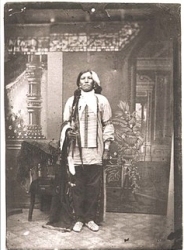 Crazy Horse, 1877, Disputed Photo – Wikipedia
Crazy Horse, 1877, Disputed Photo – Wikipedia
“Both Crazy Horse and Sitting Bull were born and grew to manhood on the High Plains of the American West, in an era when vast herds of buffalo covered the earth, and when their nomadic people could move freely, following the buffalo and lording their fighting prowess over rival Indian nations. But as idyllic as this life seemed to be, neither man had known a time without whites. Fur traders and government explorers were the first to penetrate Sioux lands, but they were soon followed by a flood of white intruders: Oregon-California Trail travelers, gold seekers, railroad men, settlers, town builders—and Bluecoats. The buffalo population plummeted, disease spread by the white man decimated villages, and conflicts with the interlopers increased.
“On June 25, 1876, in the valley of the Little Big Horn, Crazy Horse and Sitting Bull, and the warriors who were inspired to follow them, fought the last stand of the Sioux, a fierce and proud nation that had ruled the Great Plains for decades. It was their greatest victory, but it was also the beginning of the end for their treasured and sacred way of life. And in the years to come, both Crazy Horse and Sitting Bull, defiant to the end, would meet violent—and eerily similar—fates.
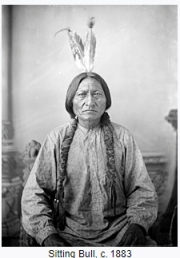 Wikipedia
Wikipedia
“An essential new addition to the canon of Indigenous American history and literature of the West, The Earth Is All That Lasts is a grand saga, both triumphant and tragic, of two fascinating and heroic leaders struggling to maintain the freedom of their people against impossible odds.”
According to “American Heritage,” Gardner “An authority on the American West, Gardner has appeared on PBS’s American Experience, as well as on the History Channel, the Travel Channel, and on NPR. He has written for the Los Angeles Times, True West, Wild West, American Cowboy, and New Mexico Magazine. He lives with his family in Cascade, Colorado.”
–Malcolm
November 19, 2022
I’d like to see daily Thanksgiving rather than saving all the thanks for one holiday
 When mother served us something for dinner we didn’t like and scarcely touched, he always said there are people in country X who don’t have any food at all. I wasn’t sure how cleaning up my plate would help those people, so after years of hearing her pronouncement I said, “Let’s just mail it to them.” That comment didn’t go well.
When mother served us something for dinner we didn’t like and scarcely touched, he always said there are people in country X who don’t have any food at all. I wasn’t sure how cleaning up my plate would help those people, so after years of hearing her pronouncement I said, “Let’s just mail it to them.” That comment didn’t go well.
Other than those days when mother got into the locoweed and served something strange, she was a great cook 24/7/365. Even though she managed meals on a tight budget, we always had plenty to eat. The older I got, the more I realized that more people than not didn’t have plenty to eat. It made me think we should be thankful for what we had.
If one feels thankful, that feeling changes his/her life. Gone are the feelings of entitlement of rich vs. poor, our country vs. a third-world country, or working people vs. those who don’t work. I don’t think many of us can imagine what it’s like to walk in another person’s shoes, much less find the empathy needed to truly understand those who don’t have what we have–so to speak.
Feeling thankful for what we have and how we live and how our friends and family are there for us doesn’t mandate our giving all of our money to worthy causes. I’ve written posts in the past about the fact many worthy causes suggest only $25 will help, but fail to consider that they are one of 50 charities that have approached us with the same rationale. I like Kiva because it lends money to people who are trying to help themselves. My donation by itself seems rather paltry but paired with hundreds of others, I believe it makes a difference.
I’m thankful for Kiva and the other groups who help those who need help. It gives us a way to reach out to thousands of people. Our lives are not perfect, but there is still much to be thankful for even though all of us meet up with the slings and arrows of outrageous fortune as a matter of course: as part of life itself. I’m sitting here typing this post in a warm office with dinner in the oven. If I weren’t thankful already, I could start with that.



